#so the earth has a liquid iron core around the inner core
Explore tagged Tumblr posts
Text
the moon has no magnetic field because it has no iron in its blood
#or i guess the moon doesnt have a blood to have iron in#this shitpost is tangentially related to actual astronomy#so the earth has a liquid iron core around the inner core#convection makes it flow continuously so it doesn't cool off#and that's theoretically the basis for earths magnetic field#moon is mainly made of crust material and is smaller and cooler#it lost its heat a lot quicker so it doesn't have a continuously flowing liquid iron core#so it doesn't generate a magnetic field (like the earth does)#so yeah no iron planet blood = no magnetic field#in conclusion risotto nero is a celestial body#amby yells
18 notes
·
View notes
Text
Writing Notes: The Moon (pt. 2)
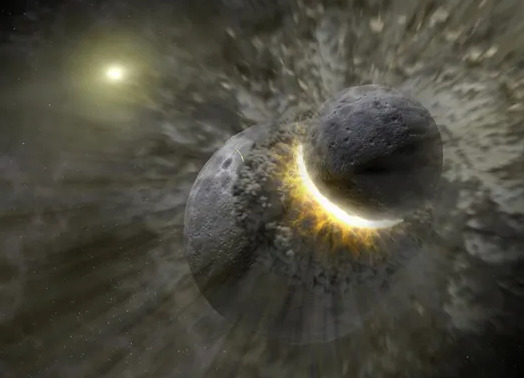
Earth’s Moon is thought to have formed in a tremendous collision. A massive object ― named Theia after the mythological Greek Titan who was the mother of Selene, goddess of the Moon ― smashed into Earth, flinging material into space that became the Moon.
The brightest and largest object in our night sky, the Moon makes Earth a more livable planet by moderating our home planet's wobble on its axis, leading to a relatively stable climate. It also causes tides, creating a rhythm that has guided humans for thousands of years.
The Moon was likely formed after a Mars-sized body collided with Earth several billion years ago.
Earth's only natural satellite is simply called "the Moon" because people didn't know other moons existed until Galileo Galilei discovered four moons orbiting Jupiter in 1610. In Latin, the Moon was called Luna, which is the main adjective for all things Moon-related: lunar.
The many missions that have explored the Moon have found no evidence to suggest it has its own living things. However, the Moon could be the site of future colonization by humans. The discovery that the Moon harbors water ice, and that the highest concentrations occur within darkened craters at the poles, makes the Moon a little more hospitable for future human colonists.
With a radius of about 1,080 miles (1,740 kilometers), the Moon is less than a third of the width of Earth. If Earth were the size of a nickel, the Moon would be about as big as a coffee bean.
The Moon is an average of 238,855 miles (384,400 kilometers) away. That means 30 Earth-sized planets could fit in between Earth and the Moon.
The Moon is slowly moving away from Earth, getting about an inch farther away each year.
The Moon is rotating at the same rate that it revolves around Earth (called synchronous rotation), so the same hemisphere faces Earth all the time. Some people call the far side – the hemisphere we never see from Earth – the "dark side" but that's misleading. As the Moon orbits Earth, different parts are in sunlight or darkness at different times. The changing illumination is why, from our perspective, the Moon goes through phases. During a "full moon," the hemisphere of the Moon we can see from Earth is fully illuminated by the Sun. And a "new moon" occurs when the far side of the Moon has full sunlight, and the side facing us is having its night.

The moon's near and far side.
The Moon makes a complete orbit around Earth in 27 Earth days and rotates or spins at that same rate, or in that same amount of time. Because Earth is moving as well – rotating on its axis as it orbits the Sun – from our perspective, the Moon appears to orbit us every 29 days.
The leading theory of the Moon's origin is that a Mars-sized body collided with Earth about 4.5 billion years ago. The resulting debris from both Earth and the impactor accumulated to form our natural satellite 239,000 miles (384,000 kilometers) away. The newly formed Moon was in a molten state, but within about 100 million years, most of the global "magma ocean" had crystallized, with less-dense rocks floating upward and eventually forming the lunar crust.
Earth's Moon has a core, mantle, and crust:
The Moon’s core is proportionally smaller than other terrestrial bodies' cores. The solid, iron-rich inner core is 149 miles (240 kilometers) in radius. It is surrounded by a liquid iron shell 56 miles (90 kilometers) thick. A partially molten layer with a thickness of 93 miles (150 kilometers) surrounds the iron core.
The mantle extends from the top of the partially molten layer to the bottom of the Moon's crust. It is most likely made of minerals like olivine and pyroxene, which are made up of magnesium, iron, silicon, and oxygen atoms.
The crust has a thickness of about 43 miles (70 kilometers) on the Moon’s near-side hemisphere and 93 miles (150 kilometers) on the far-side. It is made of oxygen, silicon, magnesium, iron, calcium, and aluminum, with small amounts of titanium, uranium, thorium, potassium, and hydrogen.
Long ago the Moon had active volcanoes, but today they are all dormant and have not erupted for millions of years.
With too sparse an atmosphere to impede impacts, a steady rain of asteroids, meteoroids, and comets strikes the surface of the Moon, leaving numerous craters behind. Tycho Crater is more than 52 miles (85 kilometers) wide.
Over billions of years, these impacts have ground up the surface of the Moon into fragments ranging from huge boulders to powder. Nearly the entire Moon is covered by a rubble pile of charcoal-gray, powdery dust, and rocky debris called the lunar regolith. Beneath is a region of fractured bedrock referred to as the megaregolith.
The light areas of the Moon are known as the highlands. The dark features, called maria (Latin for seas), are impact basins that were filled with lava between 4.2 and 1.2 billion years ago. These light and dark areas represent rocks of different compositions and ages, which provide evidence for how the early crust may have crystallized from a lunar magma ocean. The craters themselves, which have been preserved for billions of years, provide an impact history for the Moon and other bodies in the inner solar system.
If you looked in the right places on the Moon, you would find pieces of equipment, American flags, and even a camera left behind by astronauts. While you were there, you'd notice that the gravity on the surface of the Moon is one-sixth of Earth's, which is why in footage of moonwalks, astronauts appear to almost bounce across the surface.
The temperature on the Moon reaches about 260 degrees Fahrenheit (127 degrees Celsius) when in full Sun, but in darkness, the temperatures plummet to about -280 degrees Fahrenheit (-173 degrees Celsius).
During the initial exploration of the Moon, and the analysis of all the returned samples from the Apollo and the Luna missions, we thought that the surface of the Moon was dry.
The first definitive discovery of water was made in 2008 by the Indian mission Chandrayaan-1, which detected hydroxyl molecules spread across the lunar surface and concentrated at the poles. Missions such as Lunar Prospector, LCROSS, and Lunar Reconnaissance Orbiter, have not only shown that the surface of the Moon has global hydration but there are actually high concentrations of ice water in the permanently shadowed regions of the lunar poles.
Scientists also found the lunar surface releases its water when the Moon is bombarded by micrometeoroids. The surface is protected by a layer, a few centimeters of dry soil that can only be breached by large micrometeoroids. When micrometeoroids impact the surface of the Moon, most of the material in the crater is vaporized. The shock wave carries enough energy to release the water that’s coating the grains of the soil. Most of that water is released into space.
In October 2020, NASA’s Stratospheric Observatory for Infrared Astronomy (SOFIA) confirmed, for the first time, water on the sunlit surface of the Moon. This discovery indicates that water may be distributed across the lunar surface, and not limited to cold, shadowed places. SOFIA detected water molecules (H2O) in Clavius Crater, one of the largest craters visible from Earth, located in the Moon’s southern hemisphere.
The Moon has a very thin and weak atmosphere, called an exosphere. It does not provide any protection from the Sun's radiation or impacts from meteoroids.
The early Moon may have developed an internal dynamo, the mechanism for generating global magnetic fields for terrestrial planets, but today, the Moon has a very weak magnetic field. The magnetic field here on Earth is many thousands of times stronger than the Moon's magnetic field.
Earth’s Moon was born out of destruction.
Several theories about our Moon’s formation vie for dominance, but almost all share that point in common: near the time of the solar system’s formation, about 4.5 billion years ago, something ― perhaps a single object the size of Mars, perhaps a series of objects ― crashed into the young Earth and flung enough molten and vaporized debris into space to create the Moon.
Five Things We Learned from Apollo Moon Rocks
The chemical composition of Moon and Earth rocks are very similar.
The Moon was once covered in an ocean of magma.
Meteorites have shattered and melted rocks on the Moon’s surface through impacts.
Lava flowed up through cracks in the Moon’s crust and filled its impact basins.
Lunar “soil” is made of pulverized rock created by meteorite impacts.
If these writing notes helped with your poem/story, please tag me. Or leave a link in the replies. I'd love to read them!
Writing Notes: The Moon (pt. 1) ⚜ Writing Notes & References
#writing prompt#writers on tumblr#writeblr#spilled ink#moon#poets on tumblr#literature#poetry#writing notes#nature#writing reference#nasa#dark academia#worldbuilding#light academia#lit#writing ideas#writing inspiration#creative writing#fiction#writing resources
83 notes
·
View notes
Text
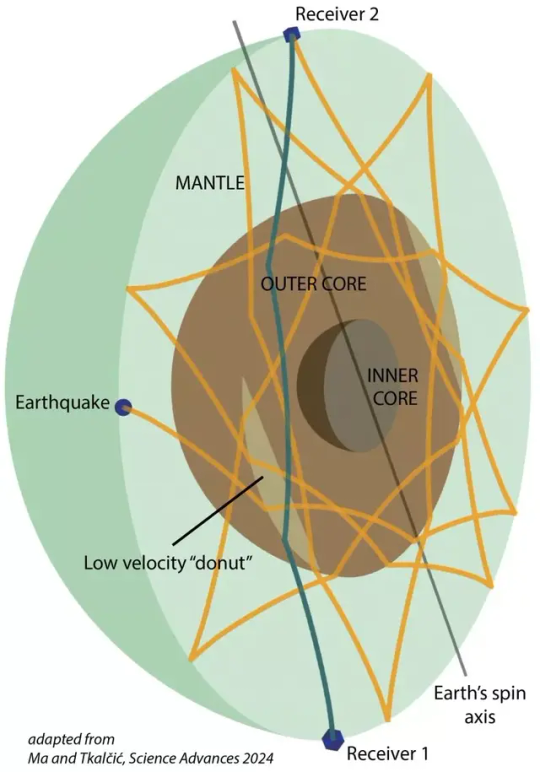

Doughnut-shaped region found inside Earth’s core deepens understanding of planet’s magnetic field
A doughnut-shaped region thousands of kilometres beneath our feet within Earth’s liquid core has been discovered by scientists from The Australian National University (ANU), providing new clues about the dynamics of our planet’s magnetic field.
The structure within Earth’s liquid core is found only at low latitudes and sits parallel to the equator. According to ANU seismologists, it has remained undetected until now.
The Earth has two core layers: the inner core, a solid layer, and the outer core, a liquid layer. Surrounding the Earth’s core is the mantle. The newly discovered doughnut-shaped region is at the top of Earth’s outer core, where the liquid core meets the mantle.
Study co-author and ANU geophysicist, Professor Hrvoje Tkalčić, said the seismic waves detected are slower in the newly discovered region than in the rest of the liquid outer core.
“The region sits parallel to the equatorial plane, is confined to the low latitudes and has a doughnut shape,” he said. “We don’t know the exact thickness of the doughnut, but we inferred that it reaches a few hundred kilometres beneath the core-mantle boundary.” Rather than using traditional seismic wave observation techniques and observing signals generated by earthquakes within the first hour, the ANU scientists analysed the similarities between waveforms many hours after the earthquake origin times, leading them to make the unique discovery. “By understanding the geometry of the paths of the waves and how they traverse the outer core’s volume, we reconstructed their travel times through the Earth, demonstrating that the newly discovered region has low seismic speeds,” Professor Tkalčić said. “The peculiar structure remained hidden until now as previous studies collected data with less volumetric coverage of the outer core by observing waves that were typically confined within one hour after the origin times of large earthquakes. “We were able to achieve much better volumetric coverage because we studied the reverberating waves for many hours after large earthquakes.” Study co-author, Dr Xiaolong Ma, said that the discovery uncovers some mysteries of the dynamics of Earth’s magnetic field. “There are still mysteries about the Earth's outer core that are yet to be solved, which requires multidisciplinary efforts from seismology, mineral physics, geomagnetism and geodynamics,” Dr Ma said. The outer core is predominantly made of liquid iron and nickel, and the vigorous movement of the electrically conductive liquid creates Earth’s magnetic field, which shields around Earth and helps to sustain all life, protecting it from damaging solar winds and harmful radiation. The scientists believe that knowing more about the Earth’s outer core’s composition, including light chemical elements, is fundamental to understanding the magnetic field and predicting when it could potentially cease or weaken. “Our findings are interesting because this low velocity within the liquid core implies that we have a high concentration of light chemical elements in these regions that would cause the seismic waves to slow down. These light elements, alongside temperature differences, help stir liquid in the outer core,” Professor Tkalčić said. “The magnetic field is a fundamental ingredient that we need for life to be sustained on the surface of our planet. “The dynamics of Earth’s magnetic field is an area of strong interest in the scientific community, so our results could promote more research about the magnetic field on both Earth and other planets.” The research is published in Science Advances.
TOP IMAGE: A diagram showing seismic waves traveling through Earth. These waves are detected at the surface and used to discern information about the structures that swirl around thousands of miles beneath our feet. Xiaolong Ma and Hrvoje Tkalčić/The Australian National University
LOWER IMAGE: Ray path of K* feature, schematic of the OC heterogeneity, and absolute PKIKP travel time residuals. Credit: Science Advances (2024). DOI: 10.1126/sciadv.adn5562
7 notes
·
View notes
Text
Earth's Core and Earthquakes
There have been reports that the earth's inner core is slowing down and even going backward. Why? Could this be dangerous? Are scientists concerned? Could this be related to the earthquakes and troubles Jesus prophesied during the beginning of sorrows? Could electricity be affected? What about the volcano or Revelation 8? What about the biggest earthquake ever that is prophesied in the 16th chapter of Revelation? Dr. Thiel and Steve Dupuie go over these matters.
A written article is available titled 'CNN: Earth’s core has slowed so much it’s moving backward'
youtube
CNN: Earth’s core has slowed so much it’s moving backward
COGwriter
CNN reported the following:
Earth’s core has slowed so much it’s moving backward, scientists confirm. Here’s what it could mean
Deep inside Earth is a solid metal ball that rotates independently of our spinning planet, like a top whirling around inside a bigger top, shrouded in mystery.
This inner core has intrigued researchers since its discovery by Danish seismologist Inge Lehmann in 1936, and how it moves — its rotation speed and direction — has been at the center of a decades-long debate. A growing body of evidence suggests the core’s spin has changed dramatically in recent years, but scientists have remained divided over what exactly is happening — and what it means. …
One promising model proposed in 2023 described an inner core that in the past had spun faster than Earth itself, but was now spinning slower. For a while, the scientists reported, the core’s rotation matched Earth’s spin. Then it slowed even more, until the core was moving backward relative to the fluid layers around it.
At the time, some experts cautioned that more data was needed to bolster this conclusion, and now another team of scientists has delivered compelling new evidence for this hypothesis about the inner core’s rotation rate. Research published June 12 in the journal Nature not only confirms the core slowdown, it supports the 2023 proposal that this core deceleration is part of a decades-long pattern of slowing down and speeding up. …
Magnetic attraction
Buried about 3,220 miles (5,180 kilometers) deep inside Earth, the solid metal inner core is surrounded by a liquid metal outer core. The inner core is made mostly of iron and nickel, and it is estimated to be as hot as the surface of the sun — about 9,800 degrees Fahrenheit (5,400 degrees Celsius).
Earth’s magnetic field yanks at this solid ball of hot metal, making it spin. At the same time, the gravity and flow of the fluid outer core and mantle drag at the core. Over many decades, the push and pull of these forces cause variations in the core’s rotational speed, Vidale said.
The sloshing of metal-rich fluid in the outer core generates electrical currents that power Earth’s magnetic field, which protects our planet from deadly solar radiation. …
Scientists study the inner core to learn how Earth’s deep interior formed and how activity connects across all the planet’s subsurface layers. The mysterious region where the liquid outer core envelops the solid inner core is especially interesting, Vidale added. As a place where liquid and solid meet, this boundary is “filled with potential for activity,” as are the core-mantle boundary and the boundary between mantle and crust.
“We might have volcanoes on the inner core boundary, for example, where solid and fluid are meeting and moving,” he said. https://www.cnn.com/2024/07/05/science/earth-inner-core-rotation-slowdown-cycle-scn/index.html
When I first saw the headline for the above CNN article, the following came to mind:
26 You shall therefore keep My statutes and My judgments, and shall not commit any of these abominations, either any of your own nation or any stranger who dwells among you 27 (for all these abominations the men of the land have done, who were before you, and thus the land is defiled), 28 lest the land vomit you out also when you defile it, (Leviticus 18:26-28)
So, sin causes the land to want to vomit off people. Worldwide sin could be a factor in the deep changes in the inner core.
LiveScience reported:
A new study confirms that Earth’s inner core has been rotating more slowly than usual since 2010. This mysterious “backtracking” could also end up slightly altering the planet’s overall rotation, lengthening our days.
The heart of our planet has been spinning unusually slowly for the past 14 years, new research confirms. And if this mysterious trend continues, it could potentially lengthen Earth’s days — though the effects would likely be imperceptible to us.
Earth’s inner core is a roughly moon-size chunk of solid iron and nickel that lies more than 3,000 miles (4,800 kilometers) below our feet. It is surrounded by the outer core — a superhot layer of molten metals similar to those in the inner core — which is surrounded by a more solid sea of molten rock, known as the mantle, and the crust. Although the entire planet rotates, the inner core can spin at a slightly different speed as the mantle and crust due to the viscosity of the outer core. …
If the inner core’s rotation continues to decelerate, its gravitational pull could eventually cause the outer layers of our planet to spin a little more slowly, altering the length of our days the researchers wrote. 06/19/24 https://www.livescience.com/planet-earth/geology/earths-rotating-inner-core-is-starting-to-slow-down-and-it-could-alter-the-length-of-our-days
A reader from Austria sent me a link to the following last August related to the core:
There is an extraordinary displacement and destabilization of the Earth’s core, a sporadic and chaotic acceleration of the planet’s rotation, and a shift in its rotational axis. This scenario is compounded by a critical weakening and emergence of atypical anomalies of the magnetic field, and a change in the composition of the upper layers of the atmosphere. These events have culminated in an extreme activation of magmatic foci, and an accompanying increase in deep mantle earthquakes – bringing about a decrease in the thermal conductivity of the ocean. As a consequential result, our oceans have lost their ability to function as a compensatory and cooling mechanism. All these alarming factors indicate only one thing – To Wit, Our planet is on the verge of self-destruction, and humanity has only a few years remaining to avert this impending catastrophe.
We urgently need to establish a unified international scientific center, essentially an international interdisciplinary alliance of the world’s best scientists, who will work on solving this problem.We need the brightest minds of this world, capable of thinking unconventionally and innovatively. We need people who are ready to collaborate and act in the interests of all of humanity. https://earthsavesciencecollaborative.com/ accessed 08/19/23
One possible reason why this is happening is that Jesus warned of “troubles” occurring during “the beginning of sorrows” (Mark 13:8). When you also read of various calamities in the Book of Revelation, it is possible that a change in the earth’s rotation may cause, or at least contribute to, some of them–such as high heat (Revelation 16:8-9), what looks to be the biggest earthquake of all time (Revelation 16:18-20), etc.
The solution would be repentance and striving to follow the true God, but humans think that they can stop what will happen in other ways. They are in error.
Notice also the following from 2019:
Earth’s magnetic pole is on the move, fast. And we don’t know why
January 11, 2019
Planet Earth is alive. Deep beneath its skin, its life blood — rivers of molten iron — pulse around its core. And this mobile iron is what generates the magnetic field that causes auroras — and keeps us alive.
But, according to the science journal Nature, something strange is going on deep down below.
It’s causing the magnetic North Pole to ‘skitter’ away from Canada, towards Siberia.
“The magnetic pole is moving so quickly that it has forced the world’s geomagnetism experts into a rare move,” Nature reports.
On January 30 (delayed due to the US Government shutdown), the World Magnetic Model — which governs modern navigation systems — is due to undergo an urgent update.
This model is a vital component of systems ranging from geopositioning systems used to navigate ships through to smartphone trackers and maps.
The current model was expected to be valid until 2020. But the magnetic pole began to shift so quickly, it was realised in 2018 that the model had to be fixed — now.
“They realised that it was so inaccurate that it was about to exceed the acceptable (safe) limit for navigational errors,” Nature reports. https://www.news.com.au/technology/science/earths-magnetic-pole-is-on-the-move-fast-and-we-dont-know-why/news-story/341c92307a6b19d25b38836c6097be9d
Jesus warned:
8 … And there will be earthquakes in various places, and there will be famines and troubles. These are the beginnings of sorrows. (Mark 13:8)
Changes is the inner core would seem to be a factor in the production of earthquakes and troubles.
As far as earthquakes go, the really big earthquake in biblical prophecy is the following one:
18 And there were noises and thunderings and lightnings; and there was a great earthquake, such a mighty and great earthquake as had not occurred since men were on the earth. 19 Now the great city was divided into three parts, and the cities of the nations fell. And great Babylon was remembered before God, to give her the cup of the wine of the fierceness of His wrath. 20 Then every island fled away, and the mountains were not found. (Revelation 16:18-20)
Notice that the above earthquake is so big that the cities of the nations will fall. Mountains will be leveled and islands “fled away” (more on this can be found in the article Islands aeand Bible Prophecy). This seems to be the biggest earthquake that will ever hit the planet with humans on it. Despite the view of ‘preterists’ that this already happened (see The Dangerous Rise of Preterists), that is nonsense.
The earthquake of Revelation 16 will be bigger than what the usual “experts” have believed was possible. It will change the planet and humble parts of humanity.
It should be noted since that apparently biggest of all earthquakes seems to take place near the end of the Day of the Lord, it probably cannot happen prior to 2028 (for more on why as well as dates, please see the articles When Can the Great Tribulation Begin? and Does God Have a 6,000 Year Plan? What Year Does the 6,000 Years End?).
Earthquakes can trigger volcanoes.
In the Book of Revelation, there is a prophecy that sounds like destruction from a volcano:
8 Then the second angel sounded: And something like a great mountain burning with fire was thrown into the sea, and a third of the sea became blood. 9 And a third of the living creatures in the sea died, and a third of the ships were destroyed. (Revelation 8:8-9)
Changes to the inner core may cause that.
While in New Zealand, we made a video about volcanic risks while was standing on top of a supervolcano:
youtube
8:30
Are supervolcanoes a real threat?
Are supervolcanoes, such as Yellowstone in the USA or various ones in New Zealand a real threat? If so, what type of threat? Are supervolcano issues consistent with biblical prophecies? If so, which ones? Could the eruption of a supervolcano make the USA, New Zealand, or other lands vulnerable to takeover in the Great Tribulation (Matthew 24:21). Dr. Thiel answers these questions while standing atop a supervolcano in a geothermal area of Rotorua, New Zealand.
Here is a link to our video: Are supervolcanoes a real threat?
The core can also affect electrical matters.
In the future, there are real electrical risks for the USA, Canada, UK, and other nations.
The Continuing Church of God has the following video on our Bible News Prophecy YouTube channel:
youtube
17:43
Electrical End of the USA ?
Could problems with the electrical power grid caused by one or more electro-magnetic pulse bombs, solar flares, and/or other phenomena help weaken the USA to the point of allowing it to be taken over? Does such potential exist? If so, is this consistent with any biblical prophecies? What are some of the severe consequences that the USA would face in the event of a electrical power grid failure? Is there evidence in scripture that the USA will be taken over in the 21st century? Some information in video is also in the news post: ’6 Totally Insane Things That Will Happen If Our Power Grid Goes Down’.
Here is a link to our video: Electrical End of the USA ?
UPDATE 08/18/24: We just added the following related video:
youtube
14:46
Earth’s Core and Earthquakes
There have been reports that the earth’s inner core is slowing down and even going backward. Why? Could this be dangerous? Are scientists concerned? Could this be related to the earthquakes and troubles Jesus prophesied during the beginning of sorrows? Could electricity be affected? What about the volcano or Revelation 8? What about the biggest earthquake ever that is prophesied in the 16th chapter of Revelation? Dr. Thiel and Steve Dupuie go over these matters.
Here is a link to our video: Earth’s Core and Earthquakes.
The inner core of the earth is changing.
There are real seismic, electrical, and other risks.
But most ignore warning signs.
Will you?
Some items that might be of assistance in understanding end-time events may include:
Weather Blessings and Sorrows Are weather problems a warning? What should be done? What does the Bible teach about weather? What about floods, droughts, heat, earthquakes, tornadoes, and solar storms? Here is a related YouTube video Does God Use Weather? A related item in the Spanish language would be Bendiciones y maldiciones del clima.
Lost Tribes and Prophecies: What will happen to Australia, the British Isles, Canada, Europe, New Zealand and the United States of America? Where did those people come from? Can you totally rely on DNA? What about other peoples? Do you really know what will happen to Europe and the English-speaking peoples? What about Africa, Asia, South America, and the Islands? This free online book provides scriptural, scientific, historical references, and commentary to address those matters. Here are links to related sermons: Lost tribes, the Bible, and DNA; Lost tribes, prophecies, and identifications; 11 Tribes, 144,000, and Multitudes; Israel, Jeremiah, Tea Tephi, and British Royalty; Gentile European Beast; Royal Succession, Samaria, and Prophecies; Asia, Islands, Latin America, Africa, and Armageddon; When Will the End of the Age Come?; Rise of the Prophesied King of the North; Christian Persecution from the Beast; WWIII and the Coming New World Order; and Woes, WWIV, and the Good News of the Kingdom of God.
Could God Have a 6,000 Year Plan? What Year Does the 6,000 Years End? Was a 6000 year time allowed for humans to rule followed by a literal thousand year reign of Christ on Earth taught by the early Christians? Does God have 7,000 year plan? What year may the six thousand years of human rule end? When will Jesus return? 2031 or 2025 or? There is also a video titled: When Does the 6000 Years End? 2031? 2035? Here is a link to the article in Spanish: ¿Tiene Dios un plan de 6,000 años?
Is God Calling You? This booklet discusses topics including calling, election, and selection. If God is calling you, how will you respond? Here is are links to related sermons: Christian Election: Is God Calling YOU? and Predestination and Your Selection; here is a message in Spanish: Me Está Llamando Dios Hoy? A short animation is also available: Is God Calling You?
Christian Repentance Do you know what repentance is? Is it really necessary for salvation? Two related sermons about this are also available: Real Repentance and Real Christian Repentance.
About Baptism Should you be baptized? Could baptism be necessary for salvation? Who should baptize and how should it be done? Here is a link to a related sermon: Let’s Talk About Baptism and Baptism, Infants, Fire, & the Second Death.
LATEST BIBLE PROPHECY INTERVIEWS
LATEST NEWS REPORTS
0 notes
Photo

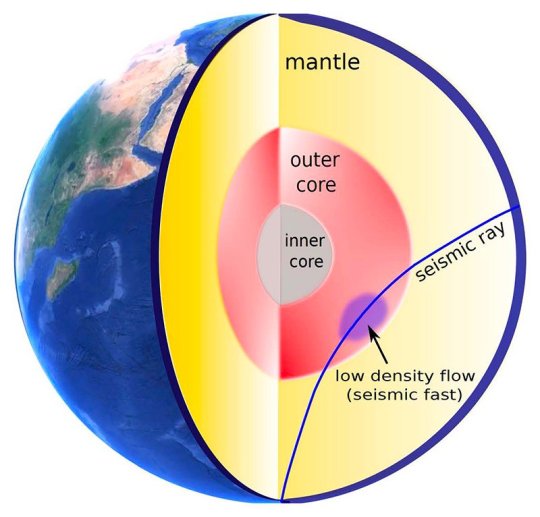
There's a Change Happening to Earth's Outer Core, as Revealed by Seismic Wave Data
Most of our knowledge about what sits at the center of our planet comes from the study of seismic waves rolling out from earthquakes. Careful analysis of these waves can reveal the composition of rocks and metal below Earth's surface.
A new study of seismic waves propagating from two different earthquakes – in similar locations but separated by a gap of 20 years – has revealed changes that are happening in Earth's outer core, the swirling layer of liquid iron and nickel between the mantle (the rock underneath the surface) and the inner core (the deepest layer).
The outer core and the iron contained within it directly influence our planet's magnetic field, which in turn provides protection from space and solar radiation that would otherwise make life on Earth impossible.
That makes understanding the outer core and its evolution over time vitally important. The data recorded from four seismic wave monitors across both earthquakes showed that waves from the later event traveled around one second faster when passing through the same region of the outer core.
"Something has changed along the path of that wave, so it can go faster now," says geoscientist Ying Zhou from Virginia Tech. "The material that was there 20 years ago is no longer there."
"This is new material, and it's lighter. These light elements will move upward and change the density in the region where they're located." ...
9 notes
·
View notes
Photo
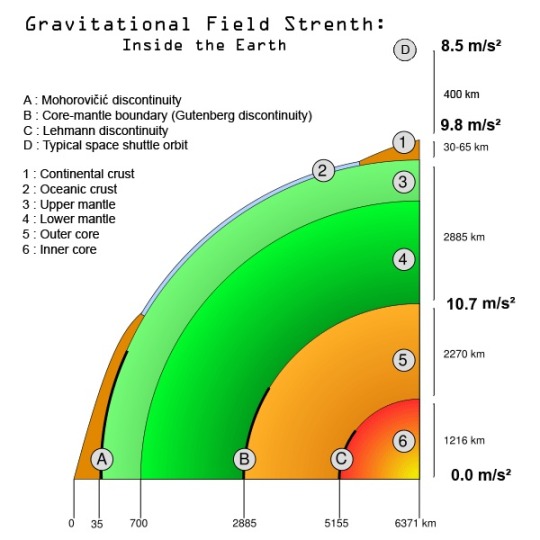
Where in the Earth would you be the heaviest? Standing on the surface of Earth, or in orbit around the Earth, to a first approximation the gravity of the planet is no different whether the planet has a lot of mass right at the center or has mass evenly distributed throughout, or has all its mass right at the surface. However, if you moved down through the planet, the gravity will change. If all Earth’s mass was at the center, you’d find that gravity increased as you approached the center, then dropped right as you reached it. If most of Earth’s mass was near the surface, you’d find gravity gradually decreased as you moved towards the center.
However, Earth is none of these end-members, it doesn’t have a neutron star at its core, it doesn’t have a high-density crust, and it isn’t homogeneous by mass. Instead, Earth has a core made of very high density, compressed iron and nickel – its density is more than 4x that of heavy rocks from the surface. If you could descend towards the core, you’re getting closer to the highest density part of the Earth, but there’s more mass above you with its own gravity. How do those 2 effects balance? You can see on this chart. As you descend through the mantle, you find that Earth’s gravity subtly increases – by less than 10%, but enough that you’re a few kilograms heavier at the bottom of the mantle than at the top. Getting closer to the core is slightly more important than the mass of all the rocks above you. Once you get into the core, as you descend into the molten outer core, gravity does the opposite, it drops. Even the liquid outer core is so dense that as you descend, the mass outside is becoming more important than getting closer to the inner core, so gravity drops. Finally, if you could get all the way to the center of the Earth, gravity would go to 0 as you’re surrounded by equal mass on all sides. So, take your current weight, figure out what 10% of that is, and add that – you’ve basically calculated how much you’d weigh if you were standing at the Core-Mantle Boundary. -JBB Image credit: https://commons.wikimedia.org/wiki/Category:Gravimetry#/media/File:Earth-G-force.png
279 notes
·
View notes
Link
Billions of years ago, Earth’s magnetic field may have gotten a jump-start from a turbulent magma ocean swirling around the planet’s core.
Our planet has generated its own magnetism for almost its entire history (SN: 1/28/19). But it’s never been clear how Earth created this magnetic field during the planet’s Archean Eon — an early geologic period roughly 2.5 billion to 4 billion years ago. Now, computer simulations suggest that a deep layer of molten rock-forming minerals known as silicates might have been the culprit.
“There’s a few billion years of Earth’s history where it’s difficult to explain what was driving the magnetic field,” says Joseph O’Rourke, a planetary scientist at Arizona State University in Tempe who was not involved with this study. This new result, he says, is a “vital piece of the puzzle.”
Today, Earth’s magnetism is likely generated in the planet’s outer core, a layer of liquid iron and nickel. Heat escaping from the solid inner core drives flows of fluid that create circulating electric currents in the outer core, turning Earth’s innards into a gigantic electromagnet. The outer core, however, is a fairly recent addition, appearing roughly a billion or so years ago, and ancient rocks preserve evidence of a planetwide magnetic field much earlier than that. So, some other mechanism must have been at work during Earth’s formative years.
One candidate for Earth’s first go at a magnetic field is a sea of liquid rock hypothesized to once have surrounded the young planet’s nascent core. To see if this ocean of molten silicates is a viable option, Lars Stixrude, a geophysicist at UCLA, and colleagues developed computer simulations to estimate the electrical properties of silicates at extreme temperatures and pressures.
The team found that, at pressures more than 10 million times Earth’s surface atmospheric pressure and temperatures comparable to those on the surface of the sun, silicates conduct electricity well enough to produce a planetwide magnetic field. The strength of that field, the team reports February 25 in Nature Communications, roughly matches measurements of fossil magnetic fields in rocks that are about 2 billion to 4 billion years old. Around the end of the Archean, the team suggests, the magma ocean would have cooled and solidified, possibly handing over magnetic field duties to an increasingly turbulent core.
The study is “an extremely important step forward in understanding the history of Earth’s magnetic field,” O’Rourke says. What’s more, it might also be relevant to other worlds today. “It’s not just a curiosity of ancient history,” he says.
Super-Earths, rocky planets a few times as massive as Earth, might retain enough internal heat to sustain a deep silicate ocean for much longer than our planet did. These planets are also the most common worlds found outside the solar system. The mechanism behind Earth’s early magnetic field, the team speculates, may therefore be operating in large rocky planets throughout the universe.
14 notes
·
View notes
Text
Astronomy 101:
The Sun and Planets

The Sun is a hot ball of hydrogen and helium, is the source of all the energy and magic in the solar system, aside from the miniscule amount we get from the other stars. The amount of magic we receive from a celestial body depends on the amount of light it sends us, as well as its size, and the Sun’s average diameter is 1,391,980 kilometers, about ten times as great as Jupiter! It also sends us the most light about 400 thousand times as much as the full Moon and 12.5 billion times more than the next brightest star, Sirius 🐺. Its surface temperature is about 10,000 degrees Fahrenheit. It actually has a name – Sol, the Latin word for sun – which is where the word “solar” comes from.
The Planets strength of magic depends upon its size, among other things. The planets, in increasing order from the Sun, are Mercury, Venus, Earth, Mars, Jupiter, Saturn, Uranus, Neptune, Pluto. Jupiter, the largest planet, is more than 28 times as big in diameter as Mercury, the smallest one. The diameter of Saturn which doesn’t include its rings, is even bigger than Jupiter. The planets are divided into two groups: the inner planets and the outer planets. We will discuss the inner ones first.
The Inner Planets are Mercury, Venus, Earth, and Mars, and they are separated from the outer ones by the asteroid belt. They all have rocky surfaces and are much smaller than the outer ones, but they reflect just as much magic to us because they are closer to both the Sun and Earth. As you will learn, at the best of times, Venus reflects more magic to us than any of the outer planets, and Mars and Mercury reflect more than two of them.
Mercury, the innermost planet, has no moons, but its surface looks like that of Earth’s Moon, with mountains, plains, and craters. It has a very thin atmosphere, which exerts about 200 trillion times less pressure than Earth’s atmosphere. It’s made up mostly of oxygen, sodium, and helium, but there’s so little of it that its composition doesn’t affect the magic reflected from the surface. The sunlit side of Mercury can reach temperatures as high as 427°C, whereas the temperature can fall as low as -220°C once the Sun goes down.
Venus, which, like Mercury, has no moons, is covered entirely by a thick layer of clouds made mostly of sulphuric acid. The planet’s surface can’t be seen from above the clouds, but it has been photographed showing mountains, plains, and depressions, but not many small craters. Venus’s atmosphere exerts 92 times as much pressure as the Earth’s atmosphere and is made up of mostly carbon dioxide with a bit of nitrogen. The temperature is extremely hot, night and day and all over the planet’s surface, reaching about 462°C, even hotter than Mercury. It’s a bit cooler on the top of the tallest mountain, Maxwell Montes, where the temperatures are a nippy 380°C. Because Venus is almost the same size as the Earth, they are often called sister planets.
Mars’ surface, like Mercury’s, also has mountains, plains, and craters. It looks reddish because of the iron oxide that covers most of the planet and is blanketed with dust. Some parts of the surface look darker than others because they’re made of different types of rocks. The poles are covered with frozen water and, in the winter, frozen carbon dioxide as well. Its atmosphere, which is made up of mostly carbon dioxide, exerts about 100 times less pressure than the Earth’s. Nevertheless, it occasionally creates dust storms all around the planet, obscuring our view of Mars and preventing the Sun’s heat. The temperature ranges from -143°C at the poles to as high as 35°C at the equator at Martian noon, when the Sun is highest in the sky. Mars has two moons, Phobos and Deimos, both of which are tidally locked.
The Outer Planets: Jupiter, Saturn, Uranus, and Neptune are all made out of gas, so, unlike their inner brethren, they don’t have a surface, but they have either a solid or liquid core, and they’re huge, explaining their designation as “the gas giants.” All of the outer planets have rings, although only Saturn’s are bright enough to be seen through a small telescope.
Jupiter, made up of mostly hydrogen with a smaller amount of helium and some trace gases. The temperature outside of the planet is about -160°C, but it increases as one descends through the gases, becoming hotter than the surface of the Sun near the core. The planet emits a lot of radiation, which makes it incredibly dangerous to get anywhere near it. Jupiter has 79 known moons, 12 of which were discovered as recently as 2018. The four largest moons, Io, Europa, Ganymede, and Callisto, are called the Galilean moons, as they were discovered by Galileo.
Saturn, too, is made up of mostly hydrogen and helium. Its claim to fame isn’t what its body looks like, although there is a vortex at each of its poles, but rather its prominent rings. These are not solid but made up of chunks of frozen water. The rings are only about 20 meters thick. They extend from 6,630 to 120,700 kilometers outwards from the planet’s equator. Galileo was the first one to see the rings. The temperature just above the atmosphere is about -185°C. Saturn has 82 known moons, the largest of which is Titan. Until very recently, only 62 of those moons had been known.
Uranus and Neptune cannot be seen with the naked eye, you need at least a pair of binoculars to see them. Even with a telescope, they don’t show much in the way of surface features, although Neptune does have a dark spot. As you can imagine, it’s even colder out by Uranus and Neptune than it is near Saturn. Uranus has 27 known moons. Neptune has 14, its largest (Triton), is about 100 times as massive as all it's other moons put together. Like Jupiter & Saturn, they are both primarily made up of hydrogen and helium, but they also have a fair amount of ice, namely water, ammonia, and methane ice. They’re sometimes called the “ice giants.”
Pluto, the dwarf planet, has a rocky core surrounded by a mantle of water ice, with more exotic ices such as methane, carbon monoxide and nitrogen coating the surface. When Pluto is closer to the sun, it's surface ices thaw and form a thin atmosphere, consisting mostly of nitrogen. Pluto's low gravity, which is a little more than 1/20th of Earth's, causes this atmosphere to extend much higher in altitude. When traveling farther away from the sun, most of the atmosphere is thought to freeze and disappear. In the time that it does have an atmosphere, however it can apparently experience strong winds.
1 note
·
View note
Video
youtube
Spinning Sphere of Molten Sodium | Veritasium
An experiment on how turbulent convection in Earth's core makes a magnetic field.
I learned a lot in making this video and the one on my second channel with Prof. Jon Arnou. I changed a lot of my preconceptions, specifically I thought:
1. That the Earth's magnetic field was a passive thing - it shouldn't need a continuous input of energy to maintain itself (that seemed reasonable to me because the magnetic field has been around for a long time and it seems mostly stable). But as it turns out, the Earth is a giant electromagnet, and so of course those currents dissipate their energy as they encounter resistance in the liquid metal through which they flow. So the energy to continuously create these currents comes from the kinetic energy of the liquid metal flows in the Earth's outer core.
2. If it's convection, I'm thinking hot things rising, cooler things falling. But apparently the main effect driving convection is the compositional differences at the boundary with the Earth's inner core. This is because of the differential freezing at the boundary. Things like iron freeze into the inner core, while elements like sulfur do not. Hence the pockets of lighter material which then rise outwards.
3. I didn't get why the fluid motion was necessary for the generation of the magnetic field. I mean if it's a conducting liquid, it can conduct currents whether it moves or not. But the key is that the liquid metal can 'trap' magnetic fields. I imagine this like how iron channels magnetic fields. Then once these fields are channeled, they can be pulled and stretched, making more magnetic field.
4. Fluids operate very differently in rotating frames of reference. This is something I didn't intuitively grasp. But, as fluids move from the inner core outwards, those particles are moving much more slowly in the direction of rotation than the matter that has been there for a long time, which means the convection currents get deflected and form helices.
For more follow | 4 your brain |
#veritasium#sodium#spinning#sphere#molten#earth#simulation#magnetic#field#experiment#materials#science#fluids#metal#physics#education#get#smarter#research#4#your#brain#lesson
6 notes
·
View notes
Text
Giant Lasers Simulate Exoplanet Cores, Prove They're More Likely to Have Life
Slashdot reader vikingo9 writes, "By smashing a piece of iron to insanely high pressures, using a laser the size of a football stadium, a team of scientists led by Lawrence Livermore National Laboratory have discovered that exoplanets 4-6 times larger than Earth have an increase chance of harboring biological life." The thinking goes that a molten core "is probably required for life to develop on a planet," Popular Science points out — and this experiment suggests that molten cores of larger rocky exoplanets "should stay hot longer than those within small worlds." "We're finding so many planets, and [one of] the big questions people have are: are these planets potentially habitable?" says Rick Kraus, a physicist at Lawrence Livermore National Laboratory who led the study... Kraus and his team wanted to find other ways to discern whether a planet is habitable. They explored a planet's ability to form a magnetosphere — a magnetic field that protects it from solar radiation, like the one around Earth does for us — as a window into habitability, Kraus says. Life as we know it wouldn't be possible without the Earth's magnetic field. Magnetic fields are a result of molten planetary cores. Earth has a core composed mostly of iron, split into a solid inner core and a liquid outer core. Earth's magnetic field is caused by the convection of the liquid iron, meaning how it swirls: The cooler, denser liquid areas sink to the bottom, while the hotter ones rise like wax in a lava lamp. Studying an exoplanet's core in a laboratory is difficult because there are few ways to recreate such intense pressures and temperatures. This is the first experiment to use iron under pressures that exceed those in Earth's core, Kraus says... The team estimates that it will take a total of 6 billion years for Earth's core to solidify, whereas cores in large exoplanets of similar composition to Earth should take up to 30 percent longer. Of course, the article ends with a few caveats: One issue with extrapolating these results to exoplanets is that those super-Earths can contain elements other than iron in their core, which would change their melting temperature by an unknown amount, Driscoll says. It will also be hard to predict how exoplanets cool because the mantle, the layer of hot rock surrounding the core, plays a huge role in how quickly the core can cool. And those exoplanet mantles could be made of "pretty much anything," he says.


Read more of this story at Slashdot.
from Slashdot https://ift.tt/3A19jX7
0 notes
Text
Earth tipped on its side (and back again) in 'cosmic yo-yo' 84 million years ago
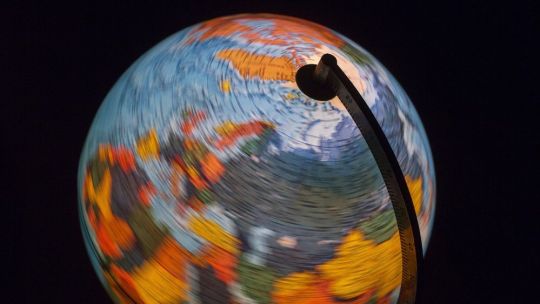

A new study has confirmed a longstanding theory that the Earth’s crust was tilted on its side around 84 million years ago. (Image credit: Shutterstock)
Earth has not always been upright. Turns out, the planet’s crust tipped on its side and back again around 84 million years ago, in a phenomenon that researchers have dubbed a “cosmic yo-yo.”
The actual name for the tipping is true polar wander (TPW), which occurs when the outer layers of a planet or moon move around its core, tilting the crust relative to the object’s axis. Some researchers had previously predicted that TPW occurred on Earth late in the Cretaceous period, between 145 million and 66 million years ago, but that was hotly debated, according to a statement by the researchers.
However, the new study strongly suggests TPW did occur on Earth. Researchers mapped the ancient movement of Earth’s crust by looking at magnetic-field data trapped inside ancient fossilized bacteria. They found that the planet tilted 12 degrees relative to its axis around 84 million years ago, before fully returning to its original position over the next 5 million years.
Related: 10 out-of-this-world images of Earth taken by Landsat satellites
“This observation represents the most recent large-scale TPW documented and challenges the notion that the [Earth’s] spin axis has been largely stable over the past 100 million years,” the researchers wrote in their paper, published online June 15 in the journal Nature Communications.
Cosmic yo-yo
Earth is made out of four main layers: the solid inner core, the liquid outer core, the mantle and the crust. During TPW, the entire planet would appear turned over on its side, but in reality only the outermost layers have moved.
“Imagine looking at Earth from space, TPW would look like the Earth tipping on its side,” co-author Joe Kirschvink, a geobiologist at the Tokyo Institute of Technology in Japan and a professor at the California Institute of Technology, said in the statement. “What’s actually happening is that the whole rocky shell of the planet [the mantle and crust] is rotating around the liquid outer core.”
During TPW the Earth’s crust rotates around the outer core, but the planet’s axis and magnetic field remains the same. (Image credit: Victor C. Tsai/Wikimedia Commons)
Individual pieces of Earth’s outermost layers are constantly moving and changing as tectonic plates collide together and subduct underneath one another; but during TPW, the outer layers move together as a single unit.
As a result, the tilt in Earth’s crust would not have resulted in any major tectonic activity or drastic changes to major ecosystems. Instead, it would have been a gradual process that would not have impacted the dinosaurs and other living things walking around on the surface.
Earth’s electromagnetic field would have been static during the TPW because it is created by the liquid inner core, which would have stayed in place. So rather than the magnetic poles moving, it is the geographic poles that start to wander.
Fossilized magnets
To test if Earth did undergo TPW during the Cretaceous, the researchers turned to magnetic minerals within limestone deposits in Italy.
“These Italian sedimentary rocks turn out to be special and very reliable because the magnetic minerals are actually fossils of bacteria that formed chains of the mineral magnetite,” co-author Sarah Slotznick, a geobiologist at Dartmouth College in New Hampshire, said in the statement.
The limestone deposits in Italy which contain the fossilized magnetite (left) and the drill holes leftover from where researchers extracted some of their samples (right). (Image credit: Ross Mitchell/Tokyo Institute of Technology)
Magnetite is a highly magnetic form of iron-oxide. Some types of bacteria can create chains of tiny magnetite crystals, which naturally orient with Earth’s magnetic field at the time of their creation. When these particular bacteria died and were fossilized during the period of TPW, these magnetite chains got locked in place.
Because Earth’s crust moved during TPW, and not its magnetic field, these magnetic fossils (which remained in surface layers of the planet) revealed how much the crust moved relative to Earth’s magnetic field over time. The team found that Earth’s crust moved a total of almost 25 degrees over a period of 5 million years.
The researchers believe that their findings now settle the question of whether Earth had a TPW during the Cretaceous.
“It is so refreshing to see this study with its abundant and beautiful paleomagnetic data,” Richard Gordon, a geophysicist at Rice University in Houston who was not involved in the study, said in the statement.
Originally published on Live Science.
New post published on: https://livescience.tech/2021/10/26/earth-tipped-on-its-side-and-back-again-in-cosmic-yo-yo-84-million-years-ago/
0 notes
Text
Scientists only looked inside Mars. This is what they found
Scientists only looked inside Mars. This is what they found
https://theministerofcapitalism.com/blog/scientists-only-looked-inside-mars-this-is-what-they-found/
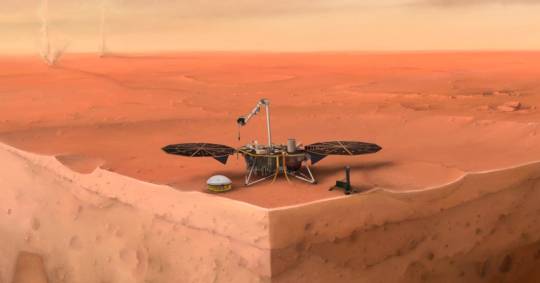
The researchers found that the density of the core was surprisingly low, at only about 6 grams per cubic centimeter, which is much lower than they expected from an iron-rich center. “It’s still a little mysterious how the core is so light,” Stähler says. There should be lighter elements, though it’s not clear exactly what they may be. Finally, he and his team hope to detect P waves produced by an earthquake that originates directly across the planet from where InSight is parked. Because they can cross the core-mantle boundary, they will carry information about the composition of the nucleus to the lander receiver. But for that to happen, Stähler says, “Mars has to play and give us this earthquake on the other side of the planet.”
In the Stähler team document, they report a central radius of 1,830 kilometers. Another team, led by ETH Zurich geophysicist Amir Khan, found that this size is so large that it leaves little room for an Earth-like lower mantle, a layer that acts as a blanket that traps heat around the core. . The Earth’s mantle is divided into two parts, with the so-called transition zone; the upper and lower levels are composed of different minerals. “The mantle of Mars is – I can blatantly say – a slightly simpler version of the Earth’s mantle, simply in terms of mineralogy,” says Khan, lead author of the paper describing the mantle.
Preliminary estimates of the radius of the nucleus using geochemical and geophysical data suggested the absence of a lower mantle, but scientists needed the seismological readings from InSight to confirm this. Without this layer, the Martian core probably cooled much more easily than that of Earth. This is key to understanding the evolution of the red planet and, in particular, why it lost its magnetic field, a barrier that would have protected the atmosphere — and potential life — from the harsh solar winds. Creating a magnetic field requires a temperature gradient between the outer core and the inner core, high enough to create circulating currents that break the liquid in the core and result in a magnetic field. But the core cooled so quickly that these convection currents ran out.
Khan’s analysis also shows that Mars has a thick lithosphere, the rigid, cold part of the mantle. This could be a clue as to why the red planet lacks the plate tectonics that drives the frenzy of volcanism on Earth. “If you have a very thick lithosphere, it will be very difficult to break this thing down and create the exact equivalent of plate tectonics on Earth,” Khan says. “Maybe Mars had it very soon, but it’s definitely closed now.”
As InSight listens to the inner vibrations of Mars, perseverance has been rolling through its dusty surface looking for signs of ancient life in the rocks, locating places to collect specimens of regolith, and learning about the geological history of Jezero. “Exploration is not a sprint, it’s a marathon,” said Thomas Zurbuchen, NASA’s associate science administrator, who opened a news conference Wednesday highlighting the rover’s first advances. first months in his new home. “Perseverance is a step in a long legacy of a carefully planned exploration of Mars that unites robotic and human exploration for the future.”
Scientists at the press conference outlined what Perseverance has been doing on its road trip so far. “The challenge is figuring out exactly where we want to go and how we will adjust everything to our schedule,” said Vivian Sun, a systems engineer at NASA’s Jet Propulsion Laboratory. Sun said they decided to divert Perseverance about 3,000 feet south of their landing site to extract their first rock samples, which will be stored in the rover’s belly and later stored on the planet’s surface for future mission. of return that will transport them to Earth.
Source link
0 notes
Text
Earth's Core and Earthquakes
There have been reports that the earth's inner core is slowing down and even going backward. Why? Could this be dangerous? Are scientists concerned? Could this be related to the earthquakes and troubles Jesus prophesied during the beginning of sorrows? Could electricity be affected? What about the volcano or Revelation 8? What about the biggest earthquake ever that is prophesied in the 16th chapter of Revelation? Dr. Thiel and Steve Dupuie go over these matters.
A written article is available titled 'CNN: Earth’s core has slowed so much it’s moving backward'
youtube
CNN: Earth’s core has slowed so much it’s moving backward
COGwriter
CNN reported the following:
Earth’s core has slowed so much it’s moving backward, scientists confirm. Here’s what it could mean
Deep inside Earth is a solid metal ball that rotates independently of our spinning planet, like a top whirling around inside a bigger top, shrouded in mystery.
This inner core has intrigued researchers since its discovery by Danish seismologist Inge Lehmann in 1936, and how it moves — its rotation speed and direction — has been at the center of a decades-long debate. A growing body of evidence suggests the core’s spin has changed dramatically in recent years, but scientists have remained divided over what exactly is happening — and what it means. …
One promising model proposed in 2023 described an inner core that in the past had spun faster than Earth itself, but was now spinning slower. For a while, the scientists reported, the core’s rotation matched Earth’s spin. Then it slowed even more, until the core was moving backward relative to the fluid layers around it.
At the time, some experts cautioned that more data was needed to bolster this conclusion, and now another team of scientists has delivered compelling new evidence for this hypothesis about the inner core’s rotation rate. Research published June 12 in the journal Nature not only confirms the core slowdown, it supports the 2023 proposal that this core deceleration is part of a decades-long pattern of slowing down and speeding up. …
Magnetic attraction
Buried about 3,220 miles (5,180 kilometers) deep inside Earth, the solid metal inner core is surrounded by a liquid metal outer core. The inner core is made mostly of iron and nickel, and it is estimated to be as hot as the surface of the sun — about 9,800 degrees Fahrenheit (5,400 degrees Celsius).
Earth’s magnetic field yanks at this solid ball of hot metal, making it spin. At the same time, the gravity and flow of the fluid outer core and mantle drag at the core. Over many decades, the push and pull of these forces cause variations in the core’s rotational speed, Vidale said.
The sloshing of metal-rich fluid in the outer core generates electrical currents that power Earth’s magnetic field, which protects our planet from deadly solar radiation. …
Scientists study the inner core to learn how Earth’s deep interior formed and how activity connects across all the planet’s subsurface layers. The mysterious region where the liquid outer core envelops the solid inner core is especially interesting, Vidale added. As a place where liquid and solid meet, this boundary is “filled with potential for activity,” as are the core-mantle boundary and the boundary between mantle and crust.
“We might have volcanoes on the inner core boundary, for example, where solid and fluid are meeting and moving,” he said. https://www.cnn.com/2024/07/05/science/earth-inner-core-rotation-slowdown-cycle-scn/index.html
When I first saw the headline for the above CNN article, the following came to mind:
26 You shall therefore keep My statutes and My judgments, and shall not commit any of these abominations, either any of your own nation or any stranger who dwells among you 27 (for all these abominations the men of the land have done, who were before you, and thus the land is defiled), 28 lest the land vomit you out also when you defile it, (Leviticus 18:26-28)
So, sin causes the land to want to vomit off people. Worldwide sin could be a factor in the deep changes in the inner core.
LiveScience reported:
A new study confirms that Earth’s inner core has been rotating more slowly than usual since 2010. This mysterious “backtracking” could also end up slightly altering the planet’s overall rotation, lengthening our days.
The heart of our planet has been spinning unusually slowly for the past 14 years, new research confirms. And if this mysterious trend continues, it could potentially lengthen Earth’s days — though the effects would likely be imperceptible to us.
Earth’s inner core is a roughly moon-size chunk of solid iron and nickel that lies more than 3,000 miles (4,800 kilometers) below our feet. It is surrounded by the outer core — a superhot layer of molten metals similar to those in the inner core — which is surrounded by a more solid sea of molten rock, known as the mantle, and the crust. Although the entire planet rotates, the inner core can spin at a slightly different speed as the mantle and crust due to the viscosity of the outer core. …
If the inner core’s rotation continues to decelerate, its gravitational pull could eventually cause the outer layers of our planet to spin a little more slowly, altering the length of our days the researchers wrote. 06/19/24 https://www.livescience.com/planet-earth/geology/earths-rotating-inner-core-is-starting-to-slow-down-and-it-could-alter-the-length-of-our-days
A reader from Austria sent me a link to the following last August related to the core:
There is an extraordinary displacement and destabilization of the Earth’s core, a sporadic and chaotic acceleration of the planet’s rotation, and a shift in its rotational axis. This scenario is compounded by a critical weakening and emergence of atypical anomalies of the magnetic field, and a change in the composition of the upper layers of the atmosphere. These events have culminated in an extreme activation of magmatic foci, and an accompanying increase in deep mantle earthquakes – bringing about a decrease in the thermal conductivity of the ocean. As a consequential result, our oceans have lost their ability to function as a compensatory and cooling mechanism. All these alarming factors indicate only one thing – To Wit, Our planet is on the verge of self-destruction, and humanity has only a few years remaining to avert this impending catastrophe.
We urgently need to establish a unified international scientific center, essentially an international interdisciplinary alliance of the world’s best scientists, who will work on solving this problem.We need the brightest minds of this world, capable of thinking unconventionally and innovatively. We need people who are ready to collaborate and act in the interests of all of humanity. https://earthsavesciencecollaborative.com/ accessed 08/19/23
One possible reason why this is happening is that Jesus warned of “troubles” occurring during “the beginning of sorrows” (Mark 13:8). When you also read of various calamities in the Book of Revelation, it is possible that a change in the earth’s rotation may cause, or at least contribute to, some of them–such as high heat (Revelation 16:8-9), what looks to be the biggest earthquake of all time (Revelation 16:18-20), etc.
The solution would be repentance and striving to follow the true God, but humans think that they can stop what will happen in other ways. They are in error.
Notice also the following from 2019:
Earth’s magnetic pole is on the move, fast. And we don’t know why
January 11, 2019
Planet Earth is alive. Deep beneath its skin, its life blood — rivers of molten iron — pulse around its core. And this mobile iron is what generates the magnetic field that causes auroras — and keeps us alive.
But, according to the science journal Nature, something strange is going on deep down below.
It’s causing the magnetic North Pole to ‘skitter’ away from Canada, towards Siberia.
“The magnetic pole is moving so quickly that it has forced the world’s geomagnetism experts into a rare move,” Nature reports.
On January 30 (delayed due to the US Government shutdown), the World Magnetic Model — which governs modern navigation systems — is due to undergo an urgent update.
This model is a vital component of systems ranging from geopositioning systems used to navigate ships through to smartphone trackers and maps.
The current model was expected to be valid until 2020. But the magnetic pole began to shift so quickly, it was realised in 2018 that the model had to be fixed — now.
“They realised that it was so inaccurate that it was about to exceed the acceptable (safe) limit for navigational errors,” Nature reports. https://www.news.com.au/technology/science/earths-magnetic-pole-is-on-the-move-fast-and-we-dont-know-why/news-story/341c92307a6b19d25b38836c6097be9d
Jesus warned:
8 … And there will be earthquakes in various places, and there will be famines and troubles. These are the beginnings of sorrows. (Mark 13:8)
Changes is the inner core would seem to be a factor in the production of earthquakes and troubles.
As far as earthquakes go, the really big earthquake in biblical prophecy is the following one:
18 And there were noises and thunderings and lightnings; and there was a great earthquake, such a mighty and great earthquake as had not occurred since men were on the earth. 19 Now the great city was divided into three parts, and the cities of the nations fell. And great Babylon was remembered before God, to give her the cup of the wine of the fierceness of His wrath. 20 Then every island fled away, and the mountains were not found. (Revelation 16:18-20)
Notice that the above earthquake is so big that the cities of the nations will fall. Mountains will be leveled and islands “fled away” (more on this can be found in the article Islands aeand Bible Prophecy). This seems to be the biggest earthquake that will ever hit the planet with humans on it. Despite the view of ‘preterists’ that this already happened (see The Dangerous Rise of Preterists), that is nonsense.
The earthquake of Revelation 16 will be bigger than what the usual “experts” have believed was possible. It will change the planet and humble parts of humanity.
It should be noted since that apparently biggest of all earthquakes seems to take place near the end of the Day of the Lord, it probably cannot happen prior to 2028 (for more on why as well as dates, please see the articles When Can the Great Tribulation Begin? and Does God Have a 6,000 Year Plan? What Year Does the 6,000 Years End?).
Earthquakes can trigger volcanoes.
In the Book of Revelation, there is a prophecy that sounds like destruction from a volcano:
8 Then the second angel sounded: And something like a great mountain burning with fire was thrown into the sea, and a third of the sea became blood. 9 And a third of the living creatures in the sea died, and a third of the ships were destroyed. (Revelation 8:8-9)
Changes to the inner core may cause that.
While in New Zealand, we made a video about volcanic risks while was standing on top of a supervolcano:
youtube
8:30
Are supervolcanoes a real threat?
Are supervolcanoes, such as Yellowstone in the USA or various ones in New Zealand a real threat? If so, what type of threat? Are supervolcano issues consistent with biblical prophecies? If so, which ones? Could the eruption of a supervolcano make the USA, New Zealand, or other lands vulnerable to takeover in the Great Tribulation (Matthew 24:21). Dr. Thiel answers these questions while standing atop a supervolcano in a geothermal area of Rotorua, New Zealand.
Here is a link to our video: Are supervolcanoes a real threat?
The core can also affect electrical matters.
In the future, there are real electrical risks for the USA, Canada, UK, and other nations.
The Continuing Church of God has the following video on our Bible News Prophecy YouTube channel:
youtube
17:43
Electrical End of the USA ?
Could problems with the electrical power grid caused by one or more electro-magnetic pulse bombs, solar flares, and/or other phenomena help weaken the USA to the point of allowing it to be taken over? Does such potential exist? If so, is this consistent with any biblical prophecies? What are some of the severe consequences that the USA would face in the event of a electrical power grid failure? Is there evidence in scripture that the USA will be taken over in the 21st century? Some information in video is also in the news post: ’6 Totally Insane Things That Will Happen If Our Power Grid Goes Down’.
Here is a link to our video: Electrical End of the USA ?
UPDATE 08/18/24: We just added the following related video:
youtube
14:46
Earth’s Core and Earthquakes
There have been reports that the earth’s inner core is slowing down and even going backward. Why? Could this be dangerous? Are scientists concerned? Could this be related to the earthquakes and troubles Jesus prophesied during the beginning of sorrows? Could electricity be affected? What about the volcano or Revelation 8? What about the biggest earthquake ever that is prophesied in the 16th chapter of Revelation? Dr. Thiel and Steve Dupuie go over these matters.
Here is a link to our video: Earth’s Core and Earthquakes.
The inner core of the earth is changing.
There are real seismic, electrical, and other risks.
But most ignore warning signs.
Will you?
Some items that might be of assistance in understanding end-time events may include:
Weather Blessings and Sorrows Are weather problems a warning? What should be done? What does the Bible teach about weather? What about floods, droughts, heat, earthquakes, tornadoes, and solar storms? Here is a related YouTube video Does God Use Weather? A related item in the Spanish language would be Bendiciones y maldiciones del clima.
Lost Tribes and Prophecies: What will happen to Australia, the British Isles, Canada, Europe, New Zealand and the United States of America? Where did those people come from? Can you totally rely on DNA? What about other peoples? Do you really know what will happen to Europe and the English-speaking peoples? What about Africa, Asia, South America, and the Islands? This free online book provides scriptural, scientific, historical references, and commentary to address those matters. Here are links to related sermons: Lost tribes, the Bible, and DNA; Lost tribes, prophecies, and identifications; 11 Tribes, 144,000, and Multitudes; Israel, Jeremiah, Tea Tephi, and British Royalty; Gentile European Beast; Royal Succession, Samaria, and Prophecies; Asia, Islands, Latin America, Africa, and Armageddon; When Will the End of the Age Come?; Rise of the Prophesied King of the North; Christian Persecution from the Beast; WWIII and the Coming New World Order; and Woes, WWIV, and the Good News of the Kingdom of God.
Could God Have a 6,000 Year Plan? What Year Does the 6,000 Years End? Was a 6000 year time allowed for humans to rule followed by a literal thousand year reign of Christ on Earth taught by the early Christians? Does God have 7,000 year plan? What year may the six thousand years of human rule end? When will Jesus return? 2031 or 2025 or? There is also a video titled: When Does the 6000 Years End? 2031? 2035? Here is a link to the article in Spanish: ¿Tiene Dios un plan de 6,000 años?
Is God Calling You? This booklet discusses topics including calling, election, and selection. If God is calling you, how will you respond? Here is are links to related sermons: Christian Election: Is God Calling YOU? and Predestination and Your Selection; here is a message in Spanish: Me Está Llamando Dios Hoy? A short animation is also available: Is God Calling You?
Christian Repentance Do you know what repentance is? Is it really necessary for salvation? Two related sermons about this are also available: Real Repentance and Real Christian Repentance.
About Baptism Should you be baptized? Could baptism be necessary for salvation? Who should baptize and how should it be done? Here is a link to a related sermon: Let’s Talk About Baptism and Baptism, Infants, Fire, & the Second Death.
LATEST BIBLE PROPHECY INTERVIEWS
LATEST NEWS REPORTS
0 notes
Photo
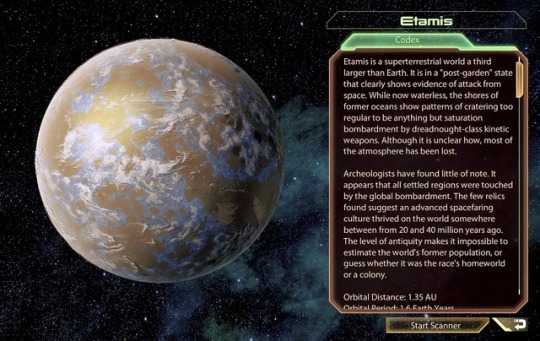

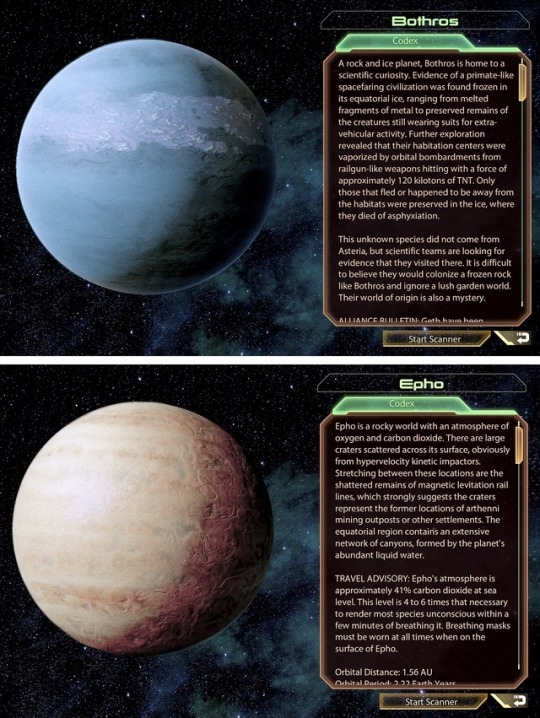
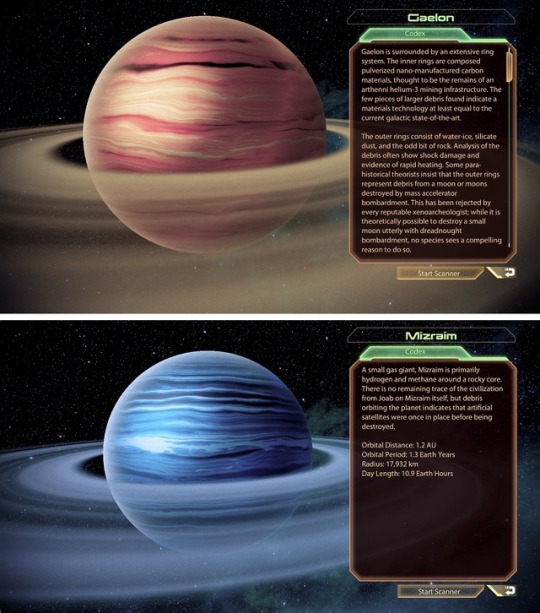
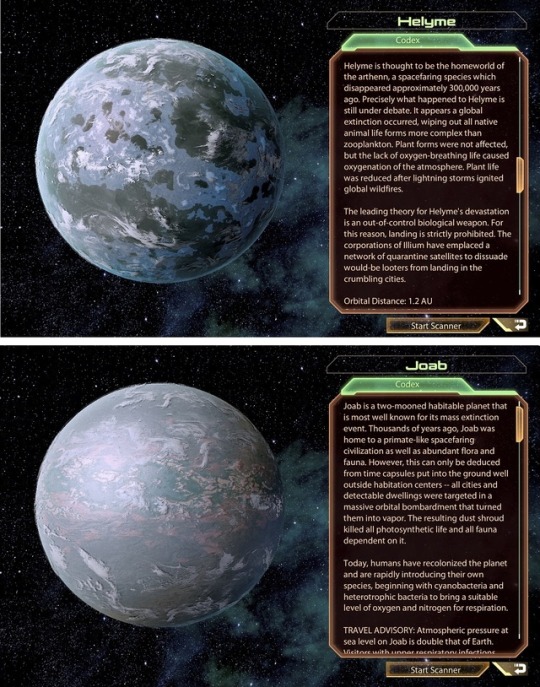

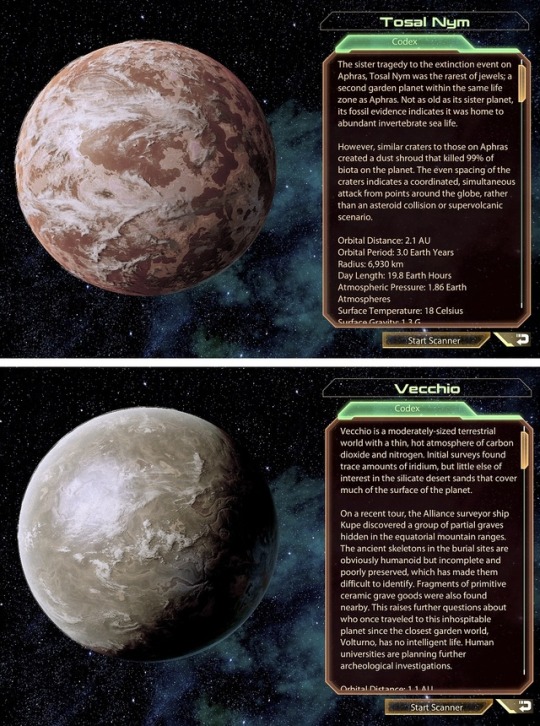
Archaeological evidence of mass extinctions Planetary biographies below the cut
Aphras is a “heavenly twin,” a planet in a star system that has not one but two worlds of sufficient mass to retain a nitrogen-oxygen atmosphere within the habitable life zone of its parent star. Fossil evidence shows abundant vertebrates and evidence of a sapient terrestrial avian species in its Bronze Age.
However, the only trace of contemporary life on the planet is that of single-celled organisms in its seas. All else has suffered from an extinction event – a series of massive impacts that vaporized vast quantities of water and lofted dust into its atmosphere. Early theories that this event was a collision with a fragmenting asteroid have now been discounted – the impact craters were aimed directly at habitation centers. (see: Tosal Nym)
Atahil is only of note for a few scattered craters. Though flattened by millions of years of high pressure, the marks of orbital bombardment strikes are unmistakable. It is generally accepted among academics that whoever hailed from or settled Schwarzschild’s second planet, Etamis, must have had outposts on Atahil as well.
Bothros is home to a scientific curiosity. Evidence of a primate-like spacefaring civilization was found frozen in its equatorial ice, ranging from melted fragments of metal to preserved remains of the creatures still wearing suits for extra-vehicular activity. Further exploration revealed that their habitation centers were vaporized by orbital bombardments from railgun-like weapons hitting with a force of approximately 120 kilotons of TNT. Only those that fled or happened to be away from the habitats were preserved in the ice, where they died of asphyxiation.
This unknown species did not come from Asteria, but scientific teams are looking for evidence that they visited there. It is difficult to believe they would colonize a frozen rock like Bothros and ignore a lush garden world. Their world of origin is also a mystery.
Epho is a rocky world with an atmosphere of oxygen and carbon dioxide. There are large craters scattered across its surface, obviously from hypervelocity kinetic impactors. Stretching between these locations are the shattered remains of magnetic levitation rail lines, which strongly suggests the craters represent the former locations of arthenni mining outposts or other settlements. The equatorial region contains an extensive network of canyons, formed by the planet’s abundant liquid water. (see: Gaelon, Helyme)
Etamis is a superterrestrial world a third larger than Earth. It is in a “post-garden” state that clearly shows evidence of attack from space. While now waterless, the shores of former oceans show patterns of cratering too regular to be anything but saturation bombardment by dreadnought-class kinetic weapons. Although it is unclear how, most of the atmosphere has been lost.
Archeologists have found little of note. It appears that all settled regions were touched by the global bombardment. The few relics found suggest an advanced spacefaring culture thrived on the world somewhere between from 20 and 40 million years ago. The level of antiquity makes it impossible to estimate the world’s former population, or guess whether it was the race’s homeworld or a colony.
Helyme is a “post-garden” world that once enjoyed an Earth-like oxygen-nitrogen atmosphere. It is still blessed with plentiful water, but a generally cold climate (and extreme seasonal shifts, courtesy of a 38-degree axial tilt).
Helyme is thought to be the homeworld of the arthenn, a spacefaring species which disappeared approximately 300,000 years ago. Precisely what happened to Helyme is still under debate. It appears a global extinction occurred, wiping out all native animal life forms more complex than zooplankton. Plant forms were not affected, but the lack of oxygen-breathing life caused oxygenation of the atmosphere. Plant life was reduced after lightning storms ignited global wildfires.
The leading theory for Helyme’s devastation is an out-of-control biological weapon. For this reason, landing is strictly prohibited. The corporations of Illium have emplaced a network of quarantine satellites to dissuade would-be looters from landing in the crumbling cities. (see: Epho, Gaelon)
Joab is a two-mooned habitable planet that is most well known for its mass extinction event. Thousands of years ago, Joab was home to a primate-like spacefaring civilization as well as abundant flora and fauna. However, this can only be deduced from time capsules put into the ground well outside habitation centers – all cities and detectable dwellings were targeted in a massive orbital bombardment that turned them into vapor. The resulting dust shroud killed all photosynthetic life and all fauna dependent on it. (see: Laban, Mizraim)
Klendagon’s most striking feature is, of course, the Great Rift valley that stretches across the southern hemisphere. What is most fascinating about the Rift is that it does not appear to be natural. The geological record suggests it is the result of a “glancing blow” by a mass accelerator round of unimaginable destructive power. This occurred some thirty-seven million years ago.
Gaelon is surrounded by an extensive ring system. The inner rings are composed pulverized nano-manufactured carbon materials, thought to be the remains of an arthenni helium-3 mining infrastructure. The few pieces of larger debris found indicate a materials technology at least equal to the current galactic state-of-the-art.
The outer rings consist of water-ice, silicate dust, and the odd bit of rock. Analysis of the debris often show [sic] shock damage and evidence of rapid heating. Some para-historical theorists insist that the outer rings represent debris from a moon or moons destroyed by mass accelerator bombardment. This has been rejected by every reputable xenoarcheologist; while it is theoretically possible to destroy a small moon utterly with dreadnought bombardment, no species sees a compelling reason to do so. (see: Epho, Helyme)
Mizraim, a small gas giant, is primarily hydrogen and methane around a rocky core. There is no remaining trace of the civilization from Joab on Mizraim itself, but debris orbiting the planet indicates that artificial satellites were once in place before being destroyed. (see: Joab, Laban)
Klendagon is an arid terrestrial, slightly larger than Earth, but with a lower density that reflects its relative lack of heavier elements. The crust is composed of tin and aluminum, with wide deserts of dust-fine sand that are easily stirred by the wind.
Klendagon’s most striking feature is, of course, the Great Rift valley that stretches across the southern hemisphere. What is most fascinating about the Rift is that it does not appear to be natural. The geological record suggests it is the result of a “glancing blow” by a mass accelerator round of unimaginable destructive power. This occurred some thirty-seven million years ago.
Laban is a desert world with sea upon sea of scorching hot iron oxide wearing away marbleized cliffs. Its atmosphere is thick and layered with significant levels of oxygen trapped under an upper helium layer. Initially, surveyors detected traces of iridium from orbit, only to find a surprising archaeological discovery - the iridium came from bunkers on the surface that were blown apart by a dreadnought-class weapon. The logical conclusion was that the civilization on Joab had reached Laban and its outposts here were destroyed to make their extermination complete. (see: Joab, Mizraim)
Tosal Nym, [ the sister tragedy to the extinction event on Aphras ], was the rarest of jewels; a second garden planet within the same life zone as Aphras. Not as old as its sister planet, its fossil evidence indicates it was home to abundant invertebrate sea life.
However, similar craters to those on Aphras created a dust shroud that killed 99% of biota on the planet. The even spacing of the craters indicates a coordinated, simultaneous attack from points around the globe, rather than an asteroid collision or supervolcanic scenario. (see: Aphras)
Vecchio is a moderately-sized terrestrial world with a thin, hot atmosphere of carbon dioxide and nitrogen. Initial surveys found trace amounts of iridium, but little else of interest in the silicate desert sands that cover much of the surface of the planet.
On a recent tour, the Alliance surveyor ship Kupe discovered a group of partial graves hidden in the equatorial mountain ranges. The ancient skeletons in the burial sites were obviously humanoid but incomplete and poorly preserved, which has made them difficult to identify. Fragments of primitive ceramic grave goods were also found nearby. This raises further questions about who once traveled to this inhospitable planet since the closest garden world, Volturno, has no intelligent life. Human universities are planning further archaeological investigations.

788 notes
·
View notes
Photo
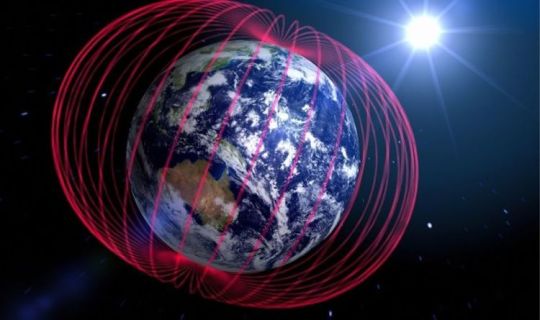
New Post has been published on https://freenews.today/2021/01/05/magnetic-field-can-influence-cells-chemical-reaction-filmed-for-the-first-time/
Magnetic field can influence cells - Chemical reaction filmed for the first time
The Earth’s magnetic field is created by the liquid iron outer core spinning around the solid inner core. The dynamic action creates an invisible field which goes through the north and south of the planet and encircling it, which leads to the Earth’s North and South Poles. Life on Earth relies on the magnetic shield, known as the magnetosphere, as it helps to protect it from deadly radiation from space.
Also, many species of animals, most notably birds, have a sense of the magnetic field which allow them to successfully navigate the globe during periods of mass-migration.
Now, scientists in Japan have managed to film the cells of an animal interacting with the magnetic field in real time.
Professor Jonathan Woodward from the University of Tokyo, who conducted the research with doctoral student Noboru Ikeya, said: “The joyous thing about this research is to see that the relationship between the spins of two individual electrons can have a major effect on biology.”
It has been thought since the 1970s that magnets can attract and repel electrons in a cell – so the magnetic field is able to influence animal behaviour by affecting chemical reactions, according to the research published in the Proceedings of the National Academy of Sciences (PNAS).
Certain molecules become excited by light, which can allow an electron to move from one molecule to another.
This can create two molecules with one electron – which is called a radical pair.
The single electrons can exist in two different spin states – if they have the same spin state, the chemical reaction is slow, while opposite spin states cause a much faster chemical reaction.
The magnetic field can influence the spin state, and thus alter the chemical reaction.
READ MORE: Earth’s magnetic field could be moving MUCH faster than thought
The team looked specifically at the flavin molecules – cryptocromes which naturally glow, or fluoresce, when exposed to blue light.
The researchers examined the glow and how it changed when an artificial magnetic field was brushed on top of them – with the results caught on camera for the first time.
They found that the cell’s fluorescence dimmed by about 3.5 percent each time the magnetic field swept over the cells.
According to the researchers, this is evidence that the Earth’s magnetic field is influencing our cells on a sub-atomic level.
Perhaps for animals and birds which are more in tune with the natural world, they can draw on these chemical reactions to navigate the globe.
Dr Woodward said: “We’ve not modified or added anything to these cells.
“We think we have extremely strong evidence that we’ve observed a purely quantum mechanical process affecting chemical activity at the cellular level.”
if(typeof utag_data.ads.fb_pixel!=="undefined"&&utag_data.ads.fb_pixel==!0)!function(f,b,e,v,n,t,s)if(f.fbq)return;n=f.fbq=function()n.callMethod?n.callMethod.apply(n,arguments):n.queue.push(arguments);if(!f._fbq)f._fbq=n;n.push=n;n.loaded=!0;n.version='2.0';n.queue=[];t=b.createElement(e);t.async=!0;t.src=v;s=b.getElementsByTagName(e)[0];s.parentNode.insertBefore(t,s)(window,document,'script','https://connect.facebook.net/en_US/fbevents.js');fbq('init','568781449942811');fbq('track','PageView') Source
0 notes
Text
Secret Base Reviews: Mars
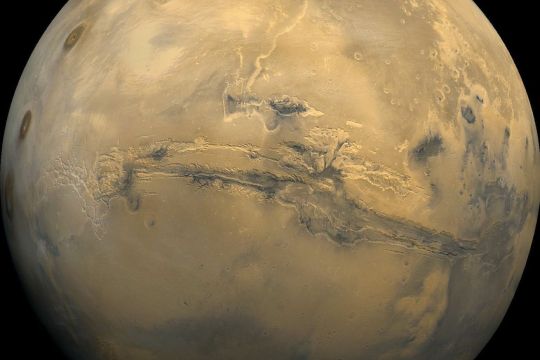
The red planet? More like the DEAD planet
Mars is dead. As corpses go, it’s pretty interesting: volcanos so big they might have altered the planet’s rotation; enough atmosphere to support seasonal weather patterns; a cleft in its surface that makes the Grand Canyon look like a roadside ditch; polar ice caps; tantalizing, suggestive geological features. It’s interesting enough that humanity has spent some time and effort getting to know it.
As of this writing there is a little plutonium-powered robot scootching around on the floor of one of Mars’ craters, getting to know the planet still further. Curiosity is the latest in a line of celebrated Mars expeditions, which began with the Vikings in the 1970s and continue to be despatched, with intermittent success, up to the present day. Our robots, however, are just the vanguard. Eventually, someone will make the trip to an alien world, and it’s incomprehensible to think that their destination will be anything other than the rusty corpse that is Mars.
Why does the Red Planet have such a hold on our scientific imagination? Firstly, it’s a matter of convenience. It’s nearby and, for certain definitions of ‘easy’, easy to get to. Exploring elsewhere would be doing things out of order. But the Martian dream isn’t just about efficiency. Percival Lowell presumably wasn’t thinking about orbital mechanics when he mapped out the planet’s (wholly illusory) canals back in the 19th century.
Nor was H.G. Wells was when he wrote The War of the Worlds. He was, however, considering death, both for Mars and the hapless inhabitants of 1880s England, for whom ecological collapse on a distant planet meant invasion. The association between Mars and war and death and blood, of course, stretches back for thousands of years. Not for nothing does the name come down to us as the Roman God of War.
It is the death of desiccation that interests us now. Over the last few decades it’s become increasingly obvious that our favorite red planet was once blue. Water was everywhere on ancient Mars. What we see now is the ghost of a once dynamic world.
There’s an important distinction between ‘dead’ and ‘inert.’ You’d never say that a rock was dead (even if that rock is literally made of dead plankton!). You’d never even say Mercury was dead. Death implies life. But it turns out with Mars, the language was reasonably precise. There’s no evidence that biological life ever existed there, but everything else suggests that billions of years ago, the planet used to boast a thicker atmosphere, a water cycle, and everything we might need to call a world inhabitable. So what happened between then and now?
Mars died, and Jupiter probably killed it.
As planets go, Mars is pretty dinky. It’s about 4,200 miles across, and has a mass around 15 percent that of Earth. Now that Pluto’s been kicked out of the club, it’s the second-smallest planet in the solar system, beating out only Mercury.
It turns out that being small is detrimental to long-term survival at the planetary level. Strong magnetic fields are needed in order to fend off solar radiation from stripping the lighter elements out of a planet’s atmosphere. On Earth, that magnetic field is powered by convection in its semi-liquid iron outer core, which creates what is known as a planetary dynamo. Mars used to have a dynamo too. You’ll be shocked to hear that it died.
Low-mass planets lose heat more rapidly than bigger ones, and while Mars still has a liquid iron core it appears that it’s no longer hot enough to generate the convection required to power an appreciable magnetic field. It definitely used to have one — you can tell by magnetized rocks laid down when the planet was young — but nobody can find any evidence of an active dynamo later than about 3.7 billion years ago. Without a working dynamo and a protective magnetic field, most of Mars’s water was blasted from its atmosphere by solar radiation long ago, leaving us with a very dead world.
What’s Jupiter got to do with this? Good question!
The last few decades have been pretty exciting for planetary scientists, who finally have more solar systems to poke around in than our own. When all we had to go on was our own neighborhood, it looked pretty reasonable. Rocky planets, some asteroids, gas giants, ice giants. Nice and orderly. But when we started looking at exoplanets, it turned out that the structure of the solar system is actually pretty unusual. Where are the super-Earths? Where are the Hot Jupiters?
It’s important to understand that we’re now straying far into the realm of the hypothetical. While we have some geological evidence of the Martian dynamo, and can indeed work out that water once flowed on the surface of the Red Planet, we’re now trying to tease out mysteries from the dawn of the solar system. This is hard, and while there obviously is a right answer, it ain’t going to be signposted. I should also note that I am in no way qualified to assess these hypotheses in anything except the ‘is this interesting’ sense.
Anyway, the most interesting hypothesis, at least where Mars is concerned, is the Grand Tack. This involves Jupiter wandering across the early Solar System like an absolutely gargantuan wrecking ball. Jupiter was the first planet to form, and the most important. It masses far more than every other planet combined, and has an incredible gravitational impact on its peers. And according to the Grand Tack hypothesis, it once decided to fall into the Sun.
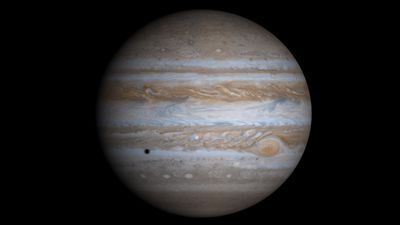
Universal History Archive/Universal Images Group
Noted dickhead Jupiter
Early Jupiter didn’t quite reach its destination, but it spiraled from its formation point about 3.5 AU* out to a mere 1.5 AU or so. This takes Jupiter well within the orbit of Mars, where it would have cannibalized almost all of young Mars’s building material. You can also imagine what this little jaunt would have done to the asteroid belt. The reason Jupiter turned around (i.e. tacked) and retreated to the outer reaches of the Solar System is Saturn, which ended up in an orbital resonance that slowly dragged it back out to about 5 AU. And a good thing too, because Jupiter getting any closer to Earth’s orbit would have meant I would definitely not be typing this right now.
*An Astronomical Unit is the current average distance from the Earth to the Sun.
If the Grand Tack hypothesis is correct — there are reasons it might not be, as you’d expect from this sort of research — Mars’s small size is easily explained: Jupiter ate most of it before Saturn could thrum (I always think of resonances as involving thrumming; I don’t know why) to the rescue. And so, thanks to this complicated turn of events, Mars’s dynamo faded, the atmosphere’s water was stripped by solar radiation, and the planet dried up and died.
There is another hypothesis about what happened to Mars’s dynamo, although the most recent evidence of Martian magnetism messes with the timing. Enough big impacts over short enough timescales might, in theory, be able to stop a planetary dynamo. Mars has seen its fair share of impacts, and indeed there is a period (again, at least partially hypothetical) of solar system history which took place about 4 billion years ago known as the Late Heavy Bombardment. The LHB, true to the ‘HB’, involved the inner planets getting absolutely hammered by asteroids, comets, etc., and there might have been enough big impactors there to shut down the Martian dynamo. Perhaps.
This, incidentally, would still have been Jupiter’s fault. Indications are that the LHB would have been caused when interactions with Jupiter flung Neptune out into its current orbit, which would have disrupted the bodies in the Kuiper Belt and thrown a good chunk of them at the inner solar system.
In other words, Mars might be a shitty heap of rust, but that’s probably not its fault. Blame Jupiter.
4
0 notes